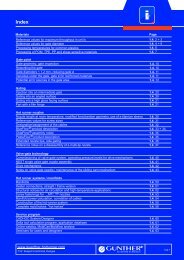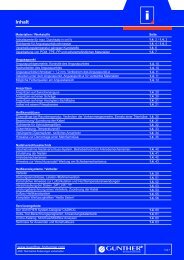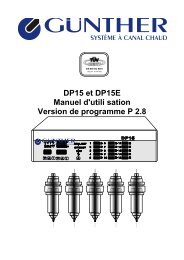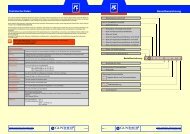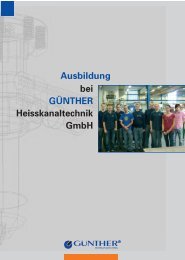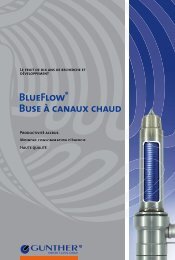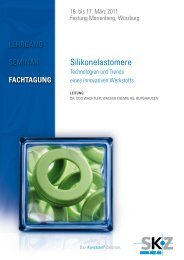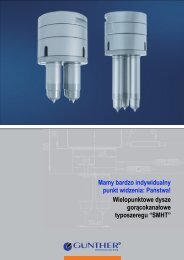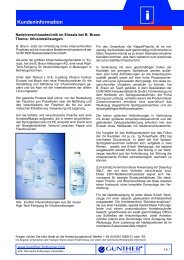Heißkanaldüsen Typ SLT/-DLT Customer information
Heißkanaldüsen Typ SLT/-DLT Customer information
Heißkanaldüsen Typ SLT/-DLT Customer information
Create successful ePaper yourself
Turn your PDF publications into a flip-book with our unique Google optimized e-Paper software.
<strong>Heißkanaldüsen</strong> <strong>Customer</strong> <strong>information</strong><br />
<strong>Typ</strong> <strong>SLT</strong>/-<strong>DLT</strong><br />
Stable and Material Saving Processing of Flame Retardant Polyamides with<br />
GÜNTHER Hot Runner Technology<br />
Material<br />
tube<br />
Heater<br />
Air<br />
Gap<br />
solidified<br />
plastic<br />
Melt<br />
Shaft made of<br />
titanium alloy<br />
Open nozzle tip<br />
Fig. 5 Detail<br />
Nozzle with shaft and open nozzle tip (DHT nozzle)<br />
The optimal thermal insulation minimizes the heat loss of<br />
the nozzle through heat conduction. This assures<br />
consistent temperature control in the nozzle and prevents<br />
an excessive rise in temperature at which the temperature<br />
measured in the nozzle is much higher than the<br />
target temperature. This prevents any possible damage<br />
of the plastic melt or additives (flame retardant) caused<br />
by an excessive rise in temperature.<br />
To keep the shear stress on the melt as low as possible,<br />
the nozzle was provided with an open nozzle tip (Fig. 5)<br />
instead of a torpedo tip. This allows an unobstructed melt<br />
flow through the nozzle and intermediate gating into the<br />
cavity. As the parts are filled through a sub-runner, the gate<br />
vestige at the injection point is of little importance.<br />
Compared to a nozzle with torpedo tip the residual sprue<br />
is slightly bigger.<br />
Fig. 6 Vertical construction of the hot runner system for<br />
“pushbutton insertion guide“, Component 1 (PA66-<br />
GF25): 4-drop, 2x 5DHT50 nozzle on sub-runner<br />
The opening characteristics of the nozzle are critical for a<br />
reliable process. Tests have shown that both nozzles<br />
with an open nozzle tip give an even filling pattern at the<br />
same temperature. These filling patterns carried out to<br />
different filling degrees can be reproduced over a large<br />
number of cycles. Figures 6 and 7 show the result of the<br />
filling analysis at 25% and 50% filling.<br />
For any questions, please contact our Application Engineering department at +49 (0) 6451 5008-31 or -63.<br />
The <strong>information</strong> is given in accordance with our present-day knowledge and is meant to provide technical background.<br />
www.guenther-hotrunner.com<br />
7/12 Subject to technical changes<br />
iA<br />
1.5. 9



